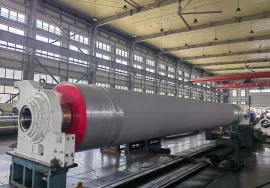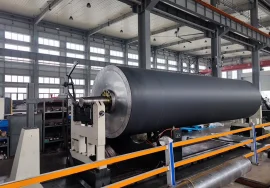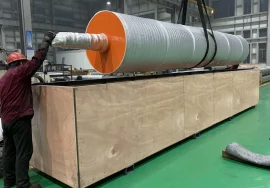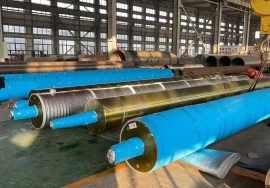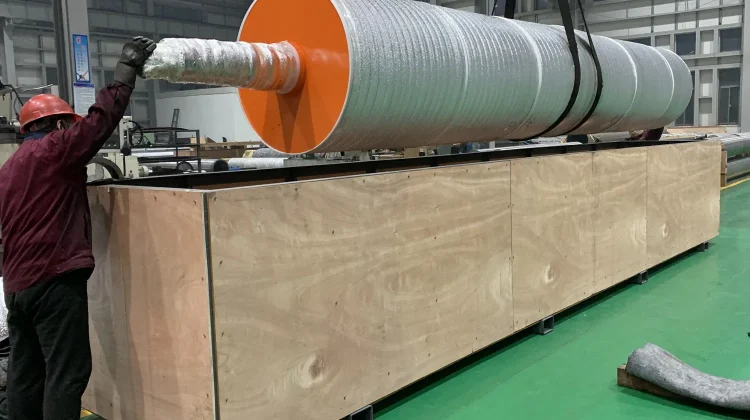
In the demanding world of paper manufacturing, achieving consistent quality and maximizing production efficiency hinges significantly on the performance of critical machinery components. Among these, paper machine rolls stand out as fundamental workhorses, interacting directly with the paper web at various stages – from forming and pressing to drying and finishing. Historically, standard roll configurations served their purpose in less strenuous operating environments. However, modern paper machines are faster, wider, and handle a much broader array of complex fiber furnish, fillers, and chemical additives. This evolution has created what we now universally recognize as ‘demanding applications,’ where the conventional limitations of standard rolls become readily apparent. Frankly speaking, relying on basic, off-the-shelf solutions in these high-stress conditions can lead to premature wear, increased maintenance downtime, compromised product quality, and ultimately, significant financial losses. It’s precisely this challenge that drives the need for advanced paper machine roll solutions, engineered specifically to perform reliably and efficiently far beyond what is considered standard.
Understanding what constitutes a ‘demanding application’ in the context of paper machine rolls is the first step towards appreciating the necessity for advanced solutions. These aren’t just machines running slightly faster; they are environments characterized by extreme pressures, high temperatures, aggressive chemical exposure, abrasive fillers, and the sheer mechanical stress of processing thousands of tons of material annually. Consider a modern high-speed press section, where rolls are subjected to immense linear pressures and rotational speeds, requiring exceptional structural integrity and surface durability. Or think about rolls operating in heavily recycled furnish lines, where abrasive contaminants can rapidly degrade standard roll coverings and surfaces. Even seemingly less dramatic sections like the dryer or calendar sections involve significant thermal cycles and specific surface requirements for finish and moisture control. These scenarios push standard materials, designs, and coverings past their breaking point, necessitating a fundamental shift in how rolls are engineered and manufactured. It’s a complex interplay of physics, chemistry, and mechanics that standard solutions simply aren’t designed to withstand effectively over the long term.
Understanding the Unique Pressures of Demanding Paper Machine Roll Applications
Delving deeper into the specifics, the demands placed upon paper machine rolls vary dramatically depending on their position and function within the machine. Forming rolls, for instance, require specific dewatering properties and wear resistance against the wire. Press rolls face high nip loads and the need for controlled deflection, alongside resistance to chemical carryover from the furnish and process water. Dryer cans must handle high internal steam pressures and external thermal stress, demanding specific material properties for efficient heat transfer and structural integrity. Calendar rolls require extremely precise surface finishes and hardness to impart the desired paper smoothness and gloss under high pressure and temperature. Each of these positions presents unique challenges that standard roll designs, often based on generalized material properties and simplified operational assumptions, cannot adequately address. The cumulative effect of these specific, intense pressures across a high-performance machine environment defines what we mean by ‘demanding applications’ and underscores why ‘standard performance’ falls short.
Specific Challenges Faced by Rolls in High-Demand Paper Processes
Beyond the general operational environment, specific paper grades introduce their own layers of complexity, significantly impacting roll demands. Producing fine papers requires impeccable surface quality on finishing rolls, intolerant of even minor imperfections that standard surfaces might exhibit over time. Packaging grades, often containing abrasive fillers or recycled fibers, necessitate roll coverings and materials with exceptional wear resistance. Specialty papers might involve corrosive chemicals or extreme temperatures during processing, demanding rolls made from or coated with highly specialized, resistant materials. Furthermore, the push for energy efficiency and reduced resource consumption places additional demands, requiring rolls that optimize dewatering, heat transfer, or minimize friction. These factors combine to create operating conditions where the longevity, performance consistency, and functional precision of a standard roll simply cannot keep pace, leading to increased downtime, higher maintenance costs, and ultimately, diminished machine productivity and paper quality.
The Limitations of Standard Performance for Paper Machine Rolls
So, what exactly defines the ‘limitations of standard performance’ when it comes to paper machine rolls in these tough applications? Primarily, it boils down to material capabilities and design constraints. Standard rolls often utilize conventional steel cores and common polymer or rubber coverings. While adequate for basic operations, these materials may lack the specific properties required for resistance to high temperatures, aggressive chemicals, or excessive abrasion encountered in modern, demanding processes. Standard roll designs might not account for the thermal expansion and contraction cycles of faster machines or the precise deflection control needed for wide, high-load nips. The result is often accelerated wear and tear. This can manifest as cracking, pitting, delamination of coverings, or dimensional instability. These issues not only shorten the lifespan of the roll but also directly impact paper quality through uneven profiles, poor dewatering, or inconsistent surface finishes. Have you ever wondered why a machine struggles to hold tight caliper tolerances on a high-speed grade? Often, it traces back to a roll component reaching its performance limit.
The economic impact of these standard performance limitations is substantial. When rolls fail prematurely or require frequent regrinding and maintenance, the machine must be stopped, leading to costly downtime. Lost production hours can quickly erode profitability. Furthermore, sub-optimal roll performance can result in higher energy consumption, for example, due to inefficient dewatering requiring more energy in the dryer section. Reject rates can increase if paper quality suffers due to roll issues. Interestingly enough, the perceived cost savings of opting for a standard roll solution upfront are often dwarfed by the cumulative expenses incurred through maintenance, downtime, energy waste, and quality issues when that roll is placed in a truly demanding application. It’s a classic case of ‘penny wise, pound foolish.’ This is why investing in advanced solutions engineered for the specific demands becomes not just an operational improvement, but a critical business strategy.
Engineering Excellence: Leveraging Advanced Materials and Designs for Superior Rolls
This is where ‘advanced paper machine roll solutions’ truly come into their own. The ‘advanced’ aspect lies in the sophisticated engineering and application of materials that go significantly ‘beyond standard.’ This includes high-strength alloys for roll shells and cores, designed to withstand immense pressures and thermal stresses. It involves cutting-edge roll coverings, utilizing specialized polymers, ceramics, or composites engineered for specific properties like exceptional wear resistance, chemical inertness, high-temperature stability, or optimized surface energy for release properties. Furthermore, advanced solutions incorporate innovative internal designs, such as sophisticated crowning profiles (including controlled or variable crown systems) to manage deflection under load, or optimized internal cooling/heating systems for precise temperature control. The manufacturing processes themselves are often more complex, involving precision machining, advanced welding techniques, and state-of-the-art coating application methods to ensure dimensional accuracy and long-term integrity.
High-Performance Materials and Coatings Tailored for Extreme Conditions
The choice of material and coating is paramount in delivering beyond standard performance. For applications involving abrasive fillers, ceramic or carbide-based coatings can offer wear resistance orders of magnitude greater than conventional rubber. In corrosive environments, specialized stainless steels or exotic alloys, potentially combined with chemically resistant polymers or coatings, are essential. High-temperature applications might necessitate materials with superior thermal stability and oxidation resistance. Even the bonding layer between the roll core and the covering is a critical piece of advanced engineering, ensuring adhesion and preventing delamination under extreme stress and temperature fluctuations. Our company understands that there is no one-size-fits-all solution. The ‘advanced’ nature of our offerings comes from our ability to analyze the specific demands of an application and engineer a roll solution – from the core material to the outermost surface – that precisely matches those requirements, ensuring maximum durability and performance consistency in the face of challenging conditions.
Achieving Beyond Standard Performance: Key Metrics and Benefits
What tangible benefits can paper manufacturers expect when they implement advanced paper machine roll solutions designed for demanding applications? The most significant is the ability to operate ‘beyond standard performance’ without compromise. This translates directly into improved machine uptime, as rolls last significantly longer between maintenance cycles and are less prone to unexpected failure. We’ve found that investing in the right advanced solution can dramatically reduce the frequency of unscheduled shutdowns, which are the most costly type of downtime. Secondly, advanced rolls contribute to enhanced paper quality. Their stability, precise surface properties, and resistance to wear help maintain uniform profiles, consistent dewatering, and desired surface finishes, even at high speeds. Consider a calendar roll with a precisely engineered surface; it ensures the desired gloss and smoothness are achieved consistently across the full width of the web.
Furthermore, advanced roll solutions often lead to operational efficiency gains. For example, press rolls designed for optimal dewatering can reduce the moisture load entering the dryer section, leading to significant energy savings. Rolls with lower friction coverings can reduce power consumption. The need for less frequent regrinding and maintenance not only saves labor costs but also minimizes material loss from the roll itself over its lifetime. In my experience, the initial investment in advanced rolls is quickly offset by these long-term savings and performance improvements. It’s not just about replacing a part; it’s about upgrading a critical system component to unlock the full potential of a modern paper machine operating under stress. This holistic view of the benefits is crucial when evaluating the value proposition of advanced solutions.
Customized Solutions for Complex, Demanding Applications
One of the hallmarks of truly advanced paper machine roll solutions is the emphasis on customization. Demanding applications are inherently unique; the specific combination of speed, load, temperature, furnish chemistry, and required paper properties varies from one machine to the next, sometimes even within the same mill producing different grades. Therefore, a ‘standard advanced’ roll is often insufficient. Effective solutions require detailed analysis of the operational parameters and challenges of a specific machine position. This involves understanding not just the basic dimensions and load requirements, but the dynamic forces, thermal profiles, chemical environment, and the specific paper quality outcomes needed. Based on this deep understanding, advanced solutions are engineered, often involving custom material selection, tailored roll coverings with specific hardness and surface properties, and optimized internal designs or crowning profiles to suit the exact operating conditions. It’s this level of bespoke engineering that truly enables performance far beyond standard capabilities.
Tailoring a roll solution involves a collaborative process. Our company works closely with paper manufacturers to diagnose current roll performance issues, understand future production goals, and analyze the specific demands of the application. This information is then used by our engineers to design and manufacture a roll that is not just robust, but optimized for peak performance and longevity in that particular challenging environment. This might mean developing a new covering formulation for exceptional release properties on a sticky furnish, or designing a roll core from a specialized alloy to resist fatigue cracking in a high-load nip. It might involve integrating advanced sensing technology to monitor roll performance in real-time. This level of detailed customization is what elevates a roll from a simple machine part to a high-performance engineered solution capable of meeting the toughest demands. Why settle for a roll designed for generic conditions when your operation faces highly specific challenges?
The Long-Term Value and Return on Investment of Advanced Solutions
From a business perspective, the adoption of advanced paper machine roll solutions for demanding applications represents a strategic investment with a compelling return. While the initial cost may be higher than standard rolls, the extended lifespan, reduced maintenance requirements, minimized downtime, improved paper quality, and potential energy savings collectively contribute to a significantly lower total cost of ownership over the life of the roll. Instead of budgeting for frequent roll changes and associated labor and production losses, mills can plan for longer operational cycles between maintenance, leading to more predictable operations and higher overall equipment effectiveness (OEE). Interestingly enough, many experts agree that the operational cost reductions achieved through advanced rolls can payback the initial investment surprisingly quickly, often within a year or two, depending on the severity of the application and the performance improvement realized.
Furthermore, the competitive advantage gained through improved paper quality and increased production capacity cannot be overstated. In today’s market, consistency and quality are key differentiators. Rolls that maintain their profile and surface properties under stress help ensure that the paper produced meets stringent specifications consistently. Increased uptime means more product can be manufactured and brought to market. Frankly speaking, in demanding applications, advanced paper machine roll solutions are not a luxury; they are a necessity for achieving and maintaining a competitive edge. They allow paper manufacturers to push their machines to their maximum potential, confidently meeting the challenges of high-speed production and specialized paper grades, ultimately driving profitability and ensuring long-term success in a challenging industry.
In summary, while standard paper machine rolls served the industry well in the past, the increasing complexity, speed, and specialized nature of modern paper manufacturing processes have created ‘demanding applications’ that require performance far ‘beyond standard.’ Advanced paper machine roll solutions, characterized by sophisticated engineering, specialized materials, tailored designs, and a deep understanding of application-specific challenges, are essential to meet these needs. They offer tangible benefits in terms of durability, reliability, paper quality, and operational efficiency, ultimately leading to a lower total cost of ownership and a significant return on investment. By choosing solutions engineered specifically for the pressures of demanding environments, paper mills can overcome the limitations of standard components and unlock new levels of productivity and quality. Have you evaluated the true cost of standard roll performance in your most demanding applications?
For more detailed information, please visit our official website: Advanced Paper Machine Roll Solutions: Beyond Standard Performance for Demanding Applications

